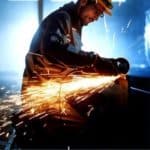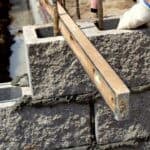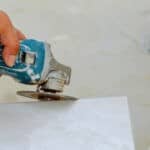Looking for a solution why is your angle grinder running slow? yes, an angle grinder is a handy tool to have around the house, but when they start running slow, it can be frustrating. No doubt angle grinder is a powerful tool that can do a lot of work quickly.
However, if the angle grinder is running slow, there may be some issues that you need to address. Here are some of the most common reasons why an angle grinder might be running slowly. There are a few things you can do to try to get your angle grinder running like new again.
Best Angle Grinders on The Running Market
More Recommended Angle Grinders for You
Why Is Your Angle Grinder Running Slow?
The grinder is overloaded.
One of the most common reasons is that the grinder is overloaded. This can be caused by trying to grind too much material at once, using an incorrect grinding wheel for the job, or using a wheel that is too small for the grinder.
Another common reason is that the grinder isn’t properly balanced. If it’s not balanced, it will vibrate excessively and cause the motor to work harder than it should, which will slow it down.
The grinding wheel is not properly aligned
One possible explanation for why your angle grinder is running slow is that the grinding wheel is not properly aligned with the grinder’s axis of rotation. This can lead to poor cutting performance and a slower cutting speed.
To fix this, you can try realigning the grinding wheel yourself or take the angle grinder to a professional to have it fixed.
The motor may be getting too hot
A motor may be getting too hot and needs to be allowed to cool down before use again. When a motor gets too hot, it may start running slowly. If this happens, it is best to stop using the motor and allow it to cool down.
If the motor continues to run slowly after it has cooled down, then there may be a problem with the motor that needs to be addressed.
The blade is dull
One potential reason your angle grinder may be running slowly is that the blade is dull and needs to be replaced. When blades get dull, they don’t cut as well as they should, which makes the angle grinder work harder and can cause it to run slowly.
You can tell when a blade is dull because it won’t make clean cuts; instead, it will leave behind jagged edges. If you think your blade may be dull, it’s important to replace it right away to avoid any further damage to the grinder or the material you’re working with.
The speed selector switch may not be set correctly
If your angle grinder is running slow, the speed selector switch may not be set correctly. This can be caused by incorrect installation, incorrect adjustment, or a faulty switch.
To fix this problem, check the switch settings and make sure they are correct. If they are correct, you may need to adjust or replace the switch.
A build-up of dirt and debris on the blade or grinding wheel
One potential reason for an angle grinder to run slowly is a build-up of dirt and debris on the blade or grinding wheel. If this is the case, it is important to clean the blade or wheel in order to restore the machine’s performance.
Another possibility is that the motor may be worn down, in which case it will need to be replaced. A final reason for a slow angle grinder could be a faulty switch, which will need to be repaired or replaced.
Check to all screws are tight and that there’s no debris caught
If your angle grinder is running slow, the first thing you should do is check to make sure that all screws are tight and there’s no debris caught in the gears or motor casing. You can do this by visually inspecting the tool and by cleaning it with a brush.
If there is debris caught in the gears or motor casing, you can try to remove it with a screwdriver or other small tool. If the angle grinder is still running slow after performing these checks, then you may need to take it to a repair shop for further inspection.
If the disc is too small for the grinder
If the disc or is too small for the grinder or if there’s too much pressure on the blade, it can cause the grinder to run slowly. This is because the grinder won’t have enough power to cut through the material quickly, and it could also damage the grinder.
Make sure that you select a disc that’s compatible with your grinder, and always use caution when applying pressure to the blade.
Check the grinding wheel
If your angle grinder is running slow, there could be a problem. One thing to check is the grinding wheel. If it’s worn down, it won’t cut as well and will cause your angle grinder to run slower.
You can also try cleaning the grinding wheel with a wire brush to remove any built-up material. If that doesn’t work, you may need to replace the grinding wheel.
Cannot lock the spindle
An angle grinder is a powerful tool that is used for grinding and polishing. It has a rotating disc that is used to cut through materials like metal, concrete, and stone. When the angle grinder is not in use, the spindle should be locked to prevent the disc from spinning.
If the spindle cannot be locked, the angle grinder will run slowly. There are several reasons why the spindle may not be able to be locked. One reason is that the lock may be defective. Another reason is that there may be something blocking the lock from engaging.
This can happen if there is dirt or debris in the locking mechanism or if the locking pin is bent or broken. If there is something blocking the lock from engaging, it can usually be fixed by cleaning out the locking mechanism or replacing the locking pin.
The Blade Common Problems
There are a few common problems that can occur with angle grinder blades, and knowing how to fix them can save you a lot of time and hassle. One problem is that the blade may run slowly, making it difficult to get the job done.
This can be fixed by sharpening the blade or replacing it if it is too dull. Another common issue is that the blade may become clogged with debris, which can make it difficult to cut through materials. This can often be fixed by cleaning the blade with a brush or blowing it off with an air compressor.
Finally, the blade may become bent or warped over time, which can make it difficult to cut straight lines. This problem can usually be fixed by replacing the blade.
Follow These Safety Tips Before Using Angle Grinders
Angle grinders or Variable Speed Angle Grinders are versatile tools that can be used for a variety of tasks, but they can also be dangerous if not used correctly. Before using an angle grinder, be sure to follow these safety tips:
- 1. Always wear safety goggles when using an angle grinder. The sparks that fly off the blade can cause serious eye injuries.
- 2. Never use an angle grinder without wearing gloves. The grinding surface can get very hot and cause burns.
- 3. Keep your hands clear of the grinding wheel at all times. The wheel can grab your skin and pull you in, resulting in serious injuries.
- 4. Make sure the disk is properly attached to the grinder and in good condition. A loose disk can fly off and cause injuries.
- 5. Make sure the grinder is unplugged before changing the grinding wheel.
- 6. Make sure the grinding wheel is the correct size and type for the job.
- 7. Make sure the blade is properly aligned before starting the machine. If the blade is not aligned, it can cause the machine to run slowly or even stall.
- 8. always use a grounded outlet when using an angle grinder – never use an extension cord!
- 9. Do not force the angle grinder to do more than it is capable of doing. This can cause it to overheat and stall.
- 10. Do not use the angle grinder if you are tired or impaired in any way.
- 11. Be aware of your surroundings when using an angle grinder.
Final Thoughts of Why Is My Angle Grinder Running Slow?
We all know that the best way to get a perfect finish is to use the right tool for the job. And, when it comes to grinding and cutting metal, there’s simply no better tool than an angle grinder. With the right attachments, they can quickly remove material or polish surfaces to a mirror finish.
However, even the best tools can sometimes let us down. If your angle grinder is running slow, there could be a number of reasons why. In this article, we’ll take a look at some of the most common causes of slow performance, and offer some tips on how to fix them.

Hi, this is Cynthia A. Rose. Welcome to my Grinder related blog. Usually, I am busy with my kitchen and cooking all day. My main desire is to create a new recipe every day. But I have to use new tools every day to create new recipes. In this blog, I will share you how to use kitchen tools properly. I will not just share cooking related equipment, I will try to review all kinds of grinders like angle grinder among you. I hope my 12 years of experience will come in handy. Thanks!










